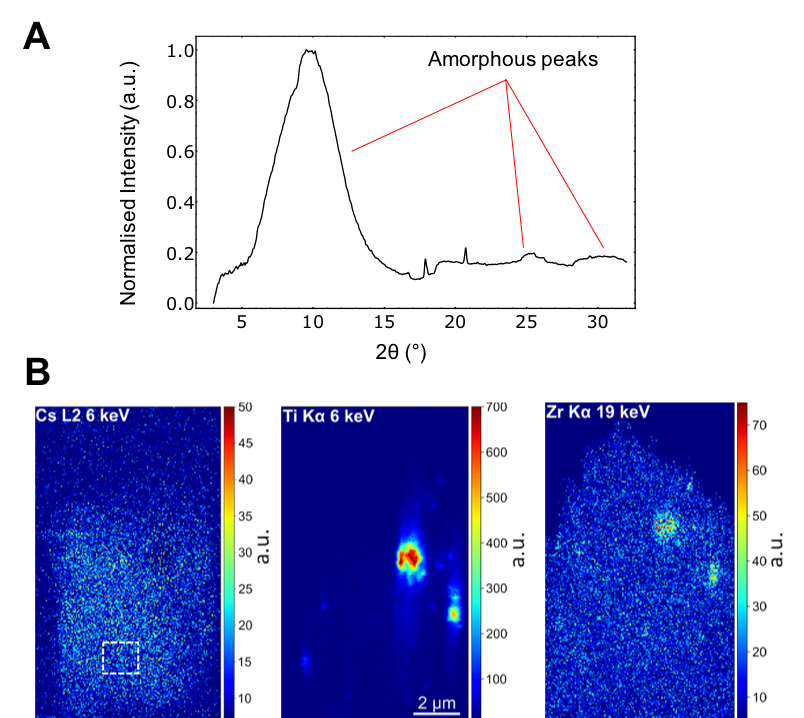Characterisation of ‘Hot’ Particles using Nano- and Micro-focus Synchrotron X-ray Techniques
- Abstract number
- 169
- Presentation Form
- Submitted Talk
- DOI
- 10.22443/rms.mmc2021.169
- Corresponding Email
- [email protected]
- Session
- Stream 3: X-ray Microscopy: A Powerful Tool to Aid the Understanding of Structures in the Life and Physical Sciences
- Authors
- Ms. Joyce W. L. Ang (3), Dr. Kazuya Morooka (2), Dr. Eitaro Kurihara (2), Dr. William R. Bower (3), Dr. J. Frederick W. Mosselmans (1), Dr. Julia Parker (1), Prof. Satoshi Utsunomiya (2), Prof. Gareth T. W. Law (3)
- Affiliations
-
1. Diamond Light Source
2. Kyushu University
3. University of Helsinki
- Keywords
X-ray microscopy, Radiochemistry
- Abstract text
Radioactive ‘hot’ particles can be deposited in the environment as a result of illicit activities, nuclear accidents (e.g., Chernobyl, Fukushima), weapons use, mining, and/or nuclear waste disposal. Understanding the long-term behaviour of such materials in the environment is important for understanding risk and environmental impact, and for designing remediation strategies. However, mechanistic knowledge of hot particle alteration processes, reaction products, and radionuclide speciation are limited, especially at finely resolved spatial scales. In this talk, we provide two case-studies that detail how micro- to nano-focus synchrotron X-ray techniques can be used as part of an analytical “tool kit” to fully characterise nuclear industry born hot particles. In turn, this data can inform safety assessments and clean-up / decommissioning efforts at radioactively contaminated sites.
In both case-studies, we examine highly radioactive micro-particles that were found in soil samples taken from nuclear exclusion zone that surrounds the Fukushima Daiichi Nuclear Power Plant (FDNPP). These particles were emitted from the damaged FDNPP reactors during the 2011 accident. Recent work by our group [1, 2] has shown that these particles are common forms of contamination in the nuclear exclusion zone, but the possible environmental and human-health impacts of the particles are not yet known. Recent work [3, 4] on Diamond Light Source Beamlines I18 (micro-focus X-ray spectroscopy) and I14 (Hard X-ray nanoprobe), and the Swiss Light Source micro-XAS Beamline, has permitted detailed chemical characterisation of these challenging materials. In case study 1, we will present micro-focus data that describes the speciation of actinide elements in whole FDNPP hot particles [3]. The data includes the first speciation information for plutonium released from the damaged FDNPP reactors. In case study 2, we present nano-probe characterisation of recently discovered hot particles derived from FDNPP reactor Unit 1 [4]. These particles have the highest ever recorded 134+137Cs radioactivities for particles released from the FDNPP. In our work, FIB sectioning of the particles permitted detailed SIMS, electron microscopy, and hard X-ray nano-probe analysis of the particles. In particular, combined electron-microscopy and synchrotron-based nano-focus XRF and XRD analyses were used to characterise the particles (e.g., Figure 1).
For both case studies we will provide an overview of sample preparation, analysis considerations, and discuss how the results inform management of the FDNPP legacy.
Figure 1. (A) the summed SR-n-XRD spectrum collected from the area outlined by the white square indicated in the Cs L2 SR-n-XRF map. (B) SR-n-XRF maps obtained from FIB section. Adapted from [4].
- References
[1] R. Ikehara et al., "Abundance and distribution of radioactive cesium-rich microparticles released from the Fukushima Daiichi Nuclear Power Plant into the environment," Chemosphere, vol. 241, p. 125019, 2020.
[2] R. Ikehara et al., "Novel method of quantifying radioactive cesium-rich microparticles (CsMPs) in the environment from the Fukushima Daiichi Nuclear Power Plant," Environmental Science & Technology, vol. 52, no. 11, pp. 6390-6398, 2018.
[3] E. Kurihara, et al., "Particulate plutonium released from the Fukushima Daiichi meltdowns," Science of the Total Environment, vol. 743, p. 140539, 2020.
[4] K. Morooka, et al., "New highly radioactive particles derived from Fukushima Daiichi reactor unit 1: Properties and environmental impacts," Science of the Total Environment, vol. 773, p. 145639, 2021.

